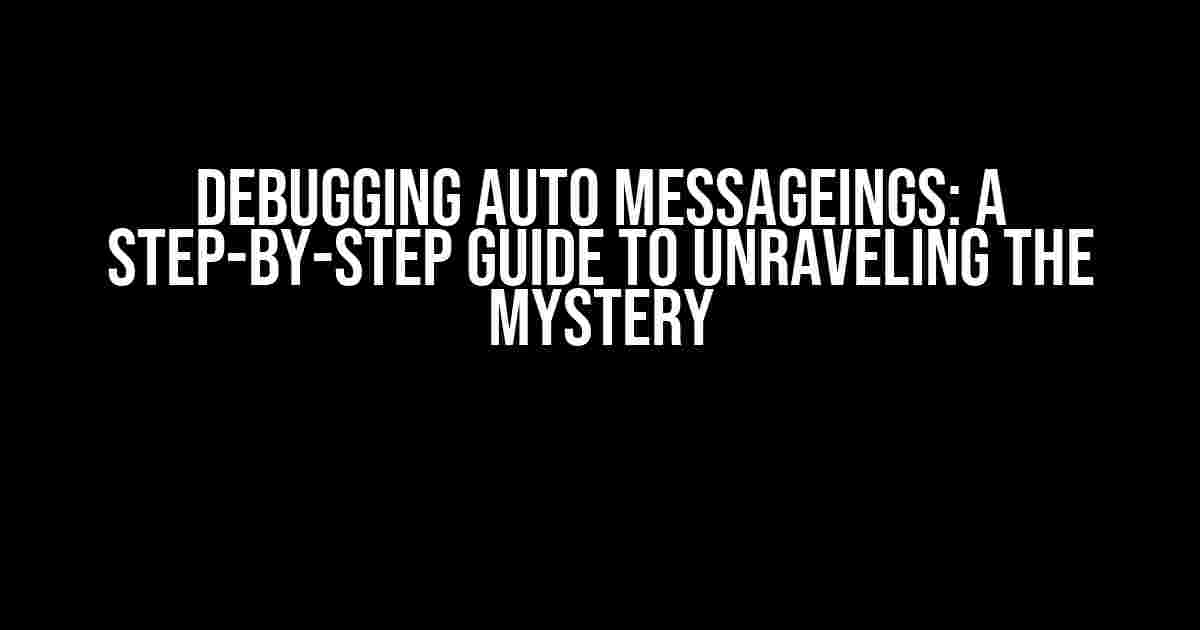Are you tired of auto messageings that don’t quite hit the mark? Are you frustrated with debugging messages that seem to have a life of their own? Worry no more! In this comprehensive guide, we’ll take you on a journey to unravel the mysteries of debugging auto messageings.
What Are Auto Messageings?
Before we dive into the world of debugging, it’s essential to understand what auto messageings are. In simple terms, auto messageings are pre-programmed messages that are sent automatically to users based on specific triggers or events. These messages can be used for a variety of purposes, including:
- Welcome messages for new subscribers
- Abandoned cart reminders
- Order confirmations
- Password reset notifications
Why Debug Auto Messageings?
Debugging auto messageings is crucial to ensure that your messages are delivered correctly and efficiently. Here are some reasons why you should debug your auto messageings:
- Improved User Experience: Debugging auto messageings helps you identify and fix errors that might affect the user experience, leading to better engagement and conversion rates.
- Reduced Errors: Debugging auto messageings reduces the likelihood of errors, ensuring that your messages are delivered correctly and on time.
- : Debugging auto messageings optimizes the performance of your messaging system, reducing the load on your servers and improving overall efficiency.
Tools for Debugging Auto Messageings
Before we dive into the debugging process, let’s take a look at some essential tools you’ll need:
| Tool | Description |
|---|---|
| Logger | A logger tool helps you track and log messages, making it easier to identify errors and debug issues. |
| Debugger | A debugger tool allows you to step through your code line by line, identifying issues and fixing bugs. |
| API Console | An API console helps you test and debug API requests, ensuring that your messages are delivered correctly. |
Step-by-Step Guide to Debugging Auto Messageings
Now that we have our tools in place, let’s dive into the step-by-step guide to debugging auto messageings:
Step 1: Identify the Issue
The first step in debugging auto messageings is to identify the issue. This involves:
- Reviewing logs and tracking errors
- Checking for common errors such as syntax errors or invalid API keys
- Identifying patterns in failed messages
Step 2: Review Code
Once you’ve identified the issue, it’s time to review your code. This involves:
// Review code for syntax errors
if (user.subscribed === true) {
sendWelcomeMessage();
} else {
console.log("User is not subscribed");
}
Step 3: Test API Requests
The next step is to test API requests using an API console. This involves:
// Test API request using API console
curl -X POST \
https://api.example.com/messages \
-H 'Content-Type: application/json' \
-d '{"message": "Welcome to our service!"}'
Step 4: Inspect Message Payload
Inspecting the message payload is crucial to identify issues with message formatting or content. This involves:
// Inspect message payload
{
"message": "Welcome to our service!",
"recipient": "[email protected]",
"sender": "[email protected]"
}
Step 5: Debug Message Delivery
The final step is to debug message delivery. This involves:
- Checking message delivery status
- Verifying message formatting and content
- Testing message delivery with different providers
Troubleshooting Common Issues
Here are some common issues you might encounter when debugging auto messageings:
Issue 1: Syntax Errors
Syntax errors can cause your auto messageings to fail. To fix syntax errors:
- Review code for syntax errors
- Use a linter to identify errors
- Test code in a development environment
Issue 2: Invalid API Keys
Invalid API keys can prevent your auto messageings from being delivered. To fix invalid API keys:
- Verify API key credentials
- Check API key expiration dates
- Regenerate API keys if necessary
Conclusion
Debugging auto messageings can be a complex task, but with the right tools and a step-by-step approach, you can identify and fix issues quickly and efficiently. By following this comprehensive guide, you’ll be able to:
- Improve user experience
- Reduce errors
- Optimize performance
Remember, debugging auto messageings is an ongoing process that requires regular monitoring and testing. By staying vigilant and proactive, you can ensure that your auto messageings are delivered correctly and efficiently, driving engagement and conversion rates.
So, what are you waiting for? Start debugging your auto messageings today and unlock the full potential of your messaging system!
Debugging Auto Messageings: Best Practices
To get the most out of your debugging efforts, follow these best practices:
- Use logging and tracking to identify issues
- Test code in a development environment
- Use debugging tools such as loggers and debuggers
- Review code regularly to identify syntax errors
- Verify API key credentials and expiration dates
Here are 5 Questions and Answers about “Debugs Auto messageings” in a creative and playful tone:
Frequently Asked Question
Got some burning questions about Debugs Auto messageings? We’ve got you covered!
What is Debugs Auto messaging, anyway?
Debugs Auto messaging is a fancy term for automated messaging systems that help businesses communicate with their customers more efficiently. Think of it like a superhero sidekick that saves the day by sending timely and personalized messages to keep your customers engaged!
Why do I need Debugs Auto messaging in my business?
You need Debugs Auto messaging because it helps you stay on top of customer conversations, saves you time and resources, and increases customer satisfaction. Plus, it’s a great way to stand out from the competition and show your customers that you care!
How does Debugs Auto messaging work?
It’s like having a personal assistant for your messaging needs! Debugs Auto messaging uses advanced algorithms and natural language processing to understand customer queries and respond accordingly. It’s like having a superhero that’s always on duty, 24/7!
Can I customize Debugs Auto messaging to fit my business needs?
You bet! Debugs Auto messaging is super customizable, so you can tailor it to fit your brand’s unique voice and style. Plus, our team of experts is always here to help you tweak and fine-tune your messaging strategy to get the most out of it!
Is Debugs Auto messaging secure and reliable?
Absolutely! Debugs Auto messaging uses top-notch security measures to ensure that your customer data is always safe and protected. We’re talking encryption, secure servers, and regular software updates – the works!


